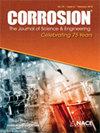Empirical Model for Predicting Corrosion Under Insulation Considering the Effects of Temperature, Salinity, and Water Content
IF 1.3
4区 材料科学
Q4 MATERIALS SCIENCE, MULTIDISCIPLINARY
引用次数: 0
Abstract
ABSTRACT Corrosion under insulation (CUI) is one of the increasing issues in industries especially oil refineries and petrochemical plants. For preventing the accident and reducing the inspection load caused by CUI, prediction model for CUI has attracted increasing attention. In this study, to construct prediction model for corrosion rate of CUI (CUI rate), the effects of water content in the insulation material, salinity, and temperature on the CUI rate were evaluated with a corrosion test simulating CUI environment. Analysis of the atmospheric corrosion monitoring sensor current showed that the CUI rate increased as the water content increased, promoting formation of the water thin film at the interface of insulation and carbon steel. Maxima of the CUI rate were observed for salinity and temperature. Salinity increased the electrical conductivity of the water thin film and promoted the corrosion reaction, and over a certain salinity, the water thin film became thicker and the CUI rate decreased due to the rate determining step in oxygen diffusion. Over a certain temperature, the CUI rate decreased due to evaporation of the water thin film and a decrease in dissolved oxygen. We constructed the prediction model for the CUI rate with a coefficient of determination of 0.87 by multiple regression analysis using the obtained test data.考虑温度、盐度和含水量影响的绝缘腐蚀预测经验模型
绝缘下腐蚀(CUI)是工业特别是炼油厂和石化装置中日益突出的问题之一。为了预防由CUI引起的事故,降低检测负荷,CUI的预测模型越来越受到人们的关注。为了构建CUI腐蚀速率(CUI rate)的预测模型,通过模拟CUI环境的腐蚀试验,评估了保温材料含水量、盐度和温度对CUI速率的影响。大气腐蚀监测传感器电流分析表明,随着水含量的增加,CUI速率增加,促进了绝缘层与碳钢界面水薄膜的形成。在盐度和温度条件下观察到最大的CUI速率。盐度提高了水薄膜的电导率,促进了腐蚀反应,在一定盐度下,由于氧扩散中的速率决定步骤,水薄膜变厚,CUI速率降低。在一定温度下,由于水薄膜的蒸发和溶解氧的减少,CUI速率降低。利用获得的试验数据,通过多元回归分析,建立了崔率的预测模型,其决定系数为0.87。
本文章由计算机程序翻译,如有差异,请以英文原文为准。
求助全文
约1分钟内获得全文
求助全文
来源期刊

Corrosion
MATERIALS SCIENCE, MULTIDISCIPLINARY-METALLURGY & METALLURGICAL ENGINEERING
CiteScore
2.80
自引率
12.50%
发文量
97
审稿时长
3 months
期刊介绍:
CORROSION is the premier research journal featuring peer-reviewed technical articles from the world’s top researchers and provides a permanent record of progress in the science and technology of corrosion prevention and control. The scope of the journal includes the latest developments in areas of corrosion metallurgy, mechanisms, predictors, cracking (sulfide stress, stress corrosion, hydrogen-induced), passivation, and CO2 corrosion.
70+ years and over 7,100 peer-reviewed articles with advances in corrosion science and engineering have been published in CORROSION. The journal publishes seven article types – original articles, invited critical reviews, technical notes, corrosion communications fast-tracked for rapid publication, special research topic issues, research letters of yearly annual conference student poster sessions, and scientific investigations of field corrosion processes. CORROSION, the Journal of Science and Engineering, serves as an important communication platform for academics, researchers, technical libraries, and universities.
Articles considered for CORROSION should have significant permanent value and should accomplish at least one of the following objectives:
• Contribute awareness of corrosion phenomena,
• Advance understanding of fundamental process, and/or
• Further the knowledge of techniques and practices used to reduce corrosion.
 求助内容:
求助内容: 应助结果提醒方式:
应助结果提醒方式:


